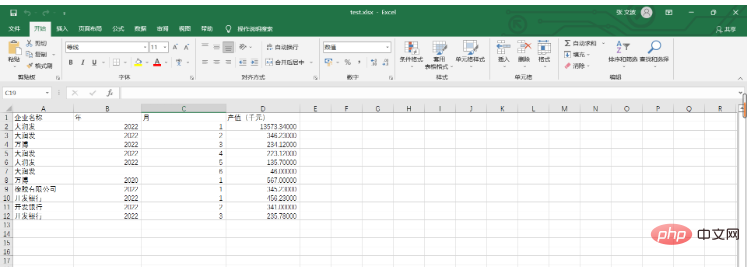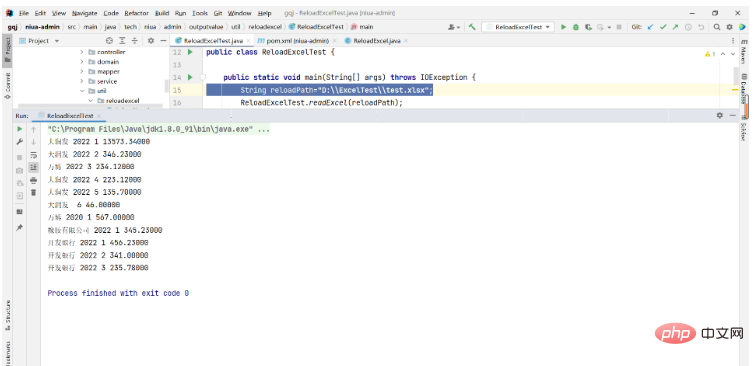How to use poi to read Excel in Java
前言
用户可以直接读取本地文件,也可以通过上传文件的形式读取excel
注意:poi对于读取到空白行的时候,会默认的认为是最后一行,将不会再读取空白行下面的数据
第一步导入依赖
<dependency>
<groupId>org.apache.poi</groupId>
<artifactId>poi</artifactId>
<version>4.1.2</version>
</dependency>
<dependency>
<groupId>org.apache.poi</groupId>
<artifactId>poi-ooxml</artifactId>
<version>4.1.2</version>
</dependency>第二步实现测试类+测试
创建ReloadExcelTest .java文件
此时找到excel的文件路径,写文件全名:路径+文件全名
例:String reloadPath=“D:\ExcelTest\test.xlsx”;
windows路径之间加\\
测试
package tech.niua.admin.outputvalue.util.reloadexcel;
import org.apache.poi.ss.usermodel.*;
import org.apache.poi.xssf.usermodel.XSSFSheet;
import org.apache.poi.xssf.usermodel.XSSFWorkbook;
import tech.niua.admin.outputvalue.domain.OutputValue;
import java.io.IOException;
public class ReloadExcelTest {
public static void readExcel(String reloadPath) throws IOException {
//1.获取工作簿
XSSFWorkbook workbook = new XSSFWorkbook(reloadPath);
//2.获取工作表
XSSFSheet sheet = workbook.getSheetAt(0);
//获取行
//cell.setCellType(Cell.CELL_TYPE_STRING); //将不同类型的数据类型转为String
int lastRowNum = sheet.getLastRowNum();
for (int i = 1; i <= lastRowNum; i++) {
OutputValue outputValueEntity = OutputValue.builder().build();
Row rowValue = sheet.getRow(i);
//获取每一行中每一个单元格的数据的数据
for (int j = 0; j < 4; j++) {
DataFormatter formatter = new DataFormatter();
String value = formatter.formatCellValue(rowValue.getCell(j));
System.out.print(value+" ");
}
System.out.println();
}
}
}注意:4.1.2版本的poi已经不在使用cell.setCellType(Cell.CELL_TYPE_STRING);这种对于读取到数据设置为String类型的这种形式,将不再支持
改用为:
DataFormatter formatter = new DataFormatter();
String value = formatter.formatCellValue(rowValue.getCell(j));
此时value就是我们读取到的值,可以做一个相应的转换存储到集合或者对象的形式接收
测试
public static void main(String[] args) throws IOException {
String reloadPath="D:\\ExcelTest\\test.xlsx";
ReloadExcelTest.readExcel(reloadPath);
}

实际应用
我们可以用集合的形式接收,或者以集合对象的形式接收,这样就能够对于读取到的数据做一个操作处理,以便于后面实现批量上传功能。
----->批量上传:前端页面上传excel文件,由系统自动导入excel的数据到数据库
The above is the detailed content of How to use poi to read Excel in Java. For more information, please follow other related articles on the PHP Chinese website!

Hot AI Tools

Undresser.AI Undress
AI-powered app for creating realistic nude photos

AI Clothes Remover
Online AI tool for removing clothes from photos.

Undress AI Tool
Undress images for free

Clothoff.io
AI clothes remover

AI Hentai Generator
Generate AI Hentai for free.

Hot Article

Hot Tools

Notepad++7.3.1
Easy-to-use and free code editor

SublimeText3 Chinese version
Chinese version, very easy to use

Zend Studio 13.0.1
Powerful PHP integrated development environment

Dreamweaver CS6
Visual web development tools

SublimeText3 Mac version
God-level code editing software (SublimeText3)

Hot Topics
 Square Root in Java
Aug 30, 2024 pm 04:26 PM
Square Root in Java
Aug 30, 2024 pm 04:26 PM
Guide to Square Root in Java. Here we discuss how Square Root works in Java with example and its code implementation respectively.
 Perfect Number in Java
Aug 30, 2024 pm 04:28 PM
Perfect Number in Java
Aug 30, 2024 pm 04:28 PM
Guide to Perfect Number in Java. Here we discuss the Definition, How to check Perfect number in Java?, examples with code implementation.
 Random Number Generator in Java
Aug 30, 2024 pm 04:27 PM
Random Number Generator in Java
Aug 30, 2024 pm 04:27 PM
Guide to Random Number Generator in Java. Here we discuss Functions in Java with examples and two different Generators with ther examples.
 Armstrong Number in Java
Aug 30, 2024 pm 04:26 PM
Armstrong Number in Java
Aug 30, 2024 pm 04:26 PM
Guide to the Armstrong Number in Java. Here we discuss an introduction to Armstrong's number in java along with some of the code.
 Weka in Java
Aug 30, 2024 pm 04:28 PM
Weka in Java
Aug 30, 2024 pm 04:28 PM
Guide to Weka in Java. Here we discuss the Introduction, how to use weka java, the type of platform, and advantages with examples.
 Smith Number in Java
Aug 30, 2024 pm 04:28 PM
Smith Number in Java
Aug 30, 2024 pm 04:28 PM
Guide to Smith Number in Java. Here we discuss the Definition, How to check smith number in Java? example with code implementation.
 Java Spring Interview Questions
Aug 30, 2024 pm 04:29 PM
Java Spring Interview Questions
Aug 30, 2024 pm 04:29 PM
In this article, we have kept the most asked Java Spring Interview Questions with their detailed answers. So that you can crack the interview.
 Break or return from Java 8 stream forEach?
Feb 07, 2025 pm 12:09 PM
Break or return from Java 8 stream forEach?
Feb 07, 2025 pm 12:09 PM
Java 8 introduces the Stream API, providing a powerful and expressive way to process data collections. However, a common question when using Stream is: How to break or return from a forEach operation? Traditional loops allow for early interruption or return, but Stream's forEach method does not directly support this method. This article will explain the reasons and explore alternative methods for implementing premature termination in Stream processing systems. Further reading: Java Stream API improvements Understand Stream forEach The forEach method is a terminal operation that performs one operation on each element in the Stream. Its design intention is






